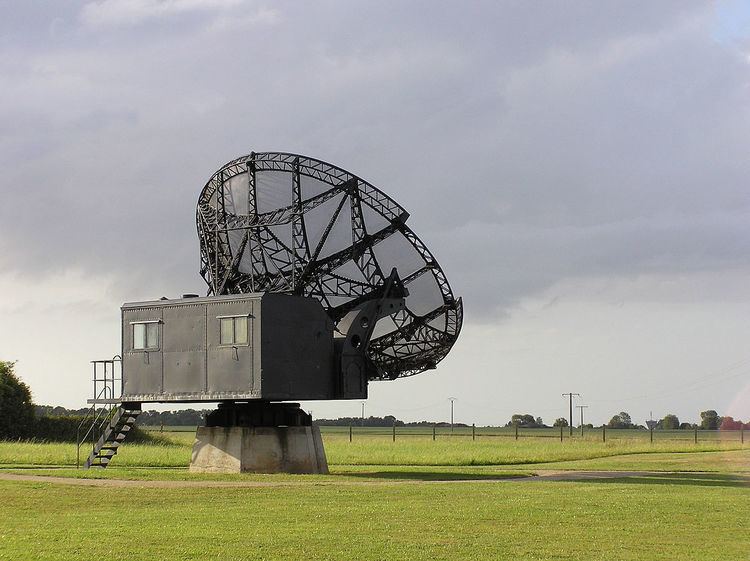16 casualties4 tanks 227 captured | ||
 | ||
The Battle of Douvres Radar Station was military engagement of World War II as part of the Invasion of Normandy, that took place the on 17 June 1944. The attack was by British 41 Commando, Royal Marines, the station and area were defended mainly by Luftwaffe ground forces. Preceded by an artillery bombardment and supported by mine-clearing and anti-bunker tanks of 79th Armoured Division, the Marines were able to secure the surrender of the garrison.
Contents
Background
The Normandy landings, the Allied invasion of German-occupied France had commenced on 6 June 1944. The radar at Douvres-la-Délivrande was the primary Luftwaffe radar station in the area—a fortified position of twenty acres—having been built by the Todt Organisation comprising five radars with thirty concrete works. Minefields, tunnels, bunkers, five 5 cm anti-tank guns, a 7.5 cm field gun, a number of mortars, twenty machine guns and a ring of barbed wire 20 feet (6.1 m) in height made up the defences.
At 11:00 p.m. on the night of 5/6 June 1944, the Allies launched intensive jamming of radar frequencies which blinded the German radar network from Cherbourg to Le Havre. On the morning of the 6th (D-Day) the antennae at Douvres-la-Délivrande were destroyed by Allied naval artillery bombardment.
The 3rd Canadian Infantry Division, who had landed nearby on Juno Beach, isolated the station but the Germans defended it for twelve days, awaiting a counter-attack by 21st Panzer Division; on one occasion it was supplied with food by a nocturnal paradrop mission from Mont-de-Marsan.
After being rested and reinforced after the initial landings, the 4th Special Service Brigade less No. 41 Commando, moved south to the Radar Station. The Brigade was to isolate the station's two well established strong-points, that would allow the 3rd Cdn Infantry Division to bypass it and advance on Caen.
Assault
After securing the perimeter, 46, 47 and 48 Commandos were sent to support the Canadians and 6th Airborne division while 41 Commando stayed behind. For the next week, the commandos harassed the strongpoint with occasional mortar fire, RAF rocket firing Hawker Typhoon strikes and volleys from two attached Royal Marine Armoured Support Group (RMASG) Centaur tanks. Although the site did not threaten Allied movements in the area, it provided radar-ranging information for Luftwaffe night fighters and constantly reported on British movements.
On 17 June at 4:30 p.m. the assault began with a bombardment from Royal Artillery 7.2-inch (180 mm) howitzers and Royal Navy ships just offshore. Under their new commander, Lieutenant Colonel Eric Palmer, 41 Commando and forty-four armoured engineering vehicles attacked from the north, while other tanks created a diversion from the south-west. After half an hour of continuous bombardment, the armour advanced with 28 Sherman Crabs (mine-clearing tanks) of the 22nd Dragoons, that cleared the way through the minefields. The 26th Assault Squadron's 17 Churchill tank AVREs with their spigot mortar demolition guns followed behind. At the same time the remainder of the squadron gave covering fire in particular against the supposed targets of the five anti-tank guns. While the Crabs were successful in clearing the minefields, AVRES with their "Flying Dustbin" high explosive bombs caused severe destruction; one hit a 50 mm gun and another an open emplacement at 60 yards (55 m) range. The effect of such fire was devastating to the German defenders.
At 5:40 p.m. the 160 men of 41 commando rushed the bombarded positions and soon after swept over the outer defences. Not long after that they entered the casemates, tunnels and bunkers, opening fire and they found many shocked and dazed Germans. Having taken nearly all the strongpoints, for the Germans it was clear that the station could no longer be defended. With their protective concrete breached the Germans surrendered. The assault was similarly successful on the small station on the Northern site that was found to contain thirty eight Germans but almost immediately they gave up; like the others they had been dazed, shocked and exhausted by the bombardment.
Aftermath
The two hundred and twenty seven remaining Luftwaffe personnel, including five officers, surrendered and the last of the 4th Special Service Brigade’s D-Day objectives was finally achieved. 41 Commando had suffered six casualties including one killed, whilst the tank crews from the 79th Armoured Division suffered three killed and seven wounded. The Crabs in their successful mine clearing had four tanks disabled by mines, one AVRE was destroyed and another three were disabled during their close-range exchange with the German defenders. With all these variable degrees of damage all but one tank was repairable.
By middle of June, with the last German stronghold near the beaches taken, the Allied stronghold in turn was secure in every way. The front-line was still 10 miles (16 km) beyond the beaches and that meant that Allied naval gunfire could break up any German attacks. Allied air forces, particularly the Typhoons dominating the sky could also break German troop concentrations.
The radar site at Douvres-la-Délivrande is now home to a museum, with two of the bunkers housing displays about the evolution and role of radar. The museum also maintains a rare preserved example of the Würzburg radar antenna.
